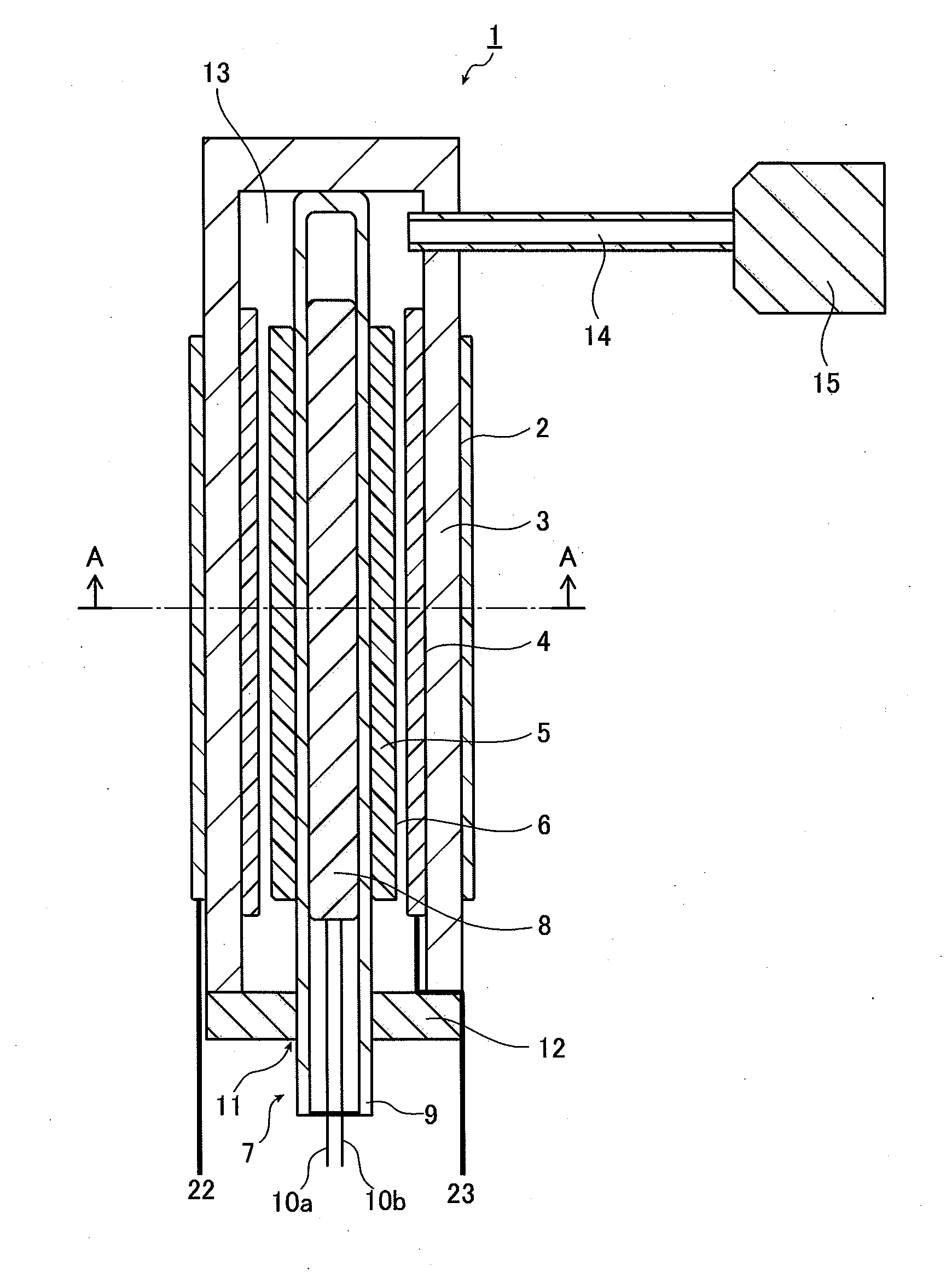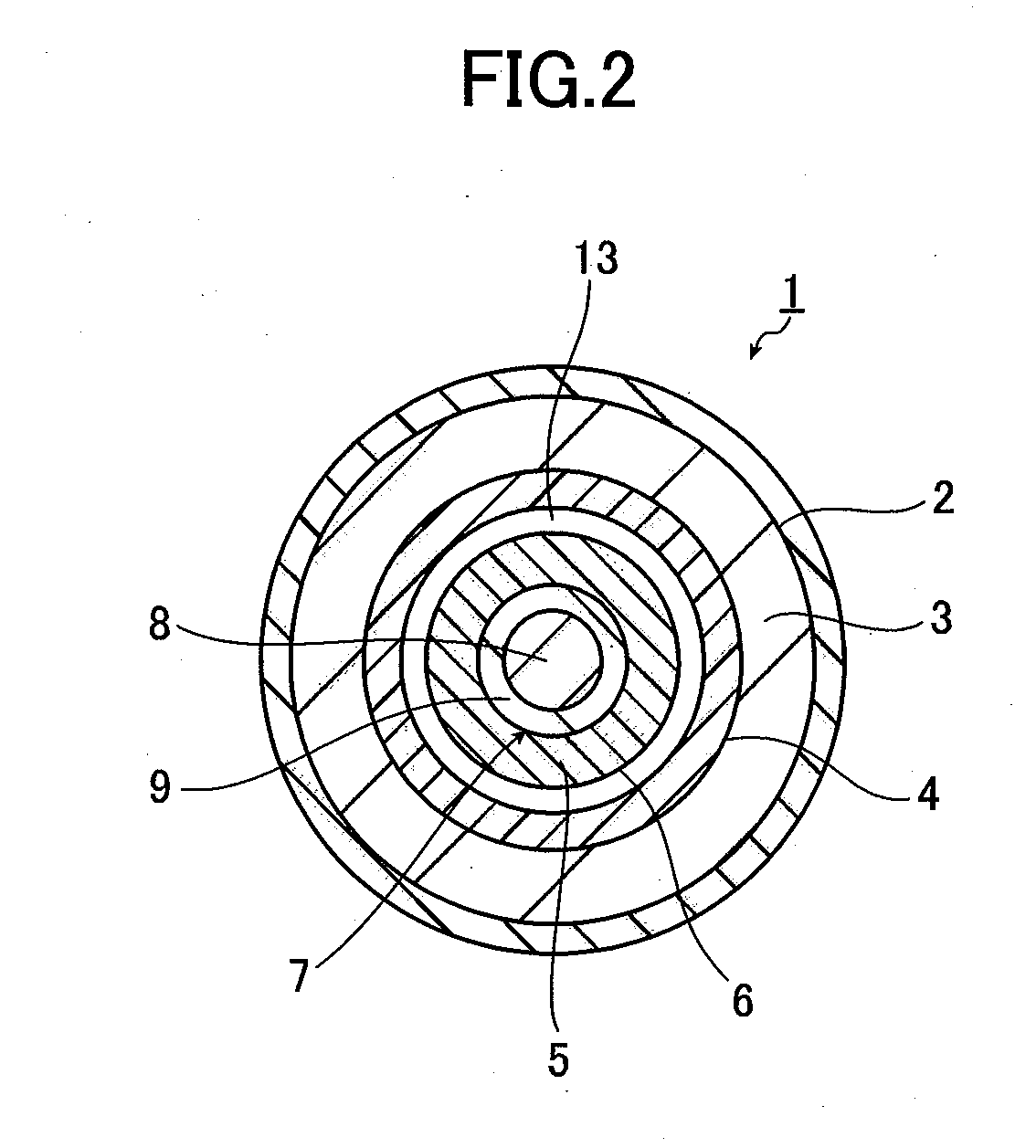Fuel cell and fuel cell system
a fuel cell and fuel cell technology, applied in the field of fuel cells, can solve the problems of occupying a large space, unable to achieve practicably extremely difficult to realize the airtight sealing space from which the fuel gas does not escape, so as to achieve efficient heating and maintain sealing properties.
- Summary
- Abstract
- Description
- Claims
- Application Information
AI Technical Summary
Benefits of technology
Problems solved by technology
Method used
Image
Examples
first embodiment
[0055]FIG. 1 shows the entire constitution of a fuel cell 1 according to the first embodiment of the present invention, and
[0056]FIG. 2 shows a cross-sectional view obtained when the fuel cell 1 of FIG. 1 is cut along the cross-section A-A.
[0057]As FIGS. 1 and 2 clearly show, the fuel cell 1 includes a cathode 2, a solid electrolyte 3, an anode 4, and an anode fuel material 5 (and an anode fuel case 6) that are each formed in a cylindrical shape, in this order from the outside, and includes a heating portion 7 at the center of the anode fuel material 5.
[0058]The cathode 2, the solid electrolyte 3, and the anode 4 are in close contact with one another, and between the anode 4 and the anode fuel material 5 (and the anode fuel case 6), a predetermined gap is disposed so as to prevent the anode 4 and the anode fuel material 5 from coming into contact with each other.
[0059]One end of the cylindrical solid electrolyte 3 is blocked, the other end thereof is provided with a cap 12 having a ...
second embodiment
[0093]In the first embodiment, the other end of the cylindrical solid electrolyte 3 of which one end is blocked is sealed with the cap 12, whereby the sealed space 13 in which the anode 4 and the anode fuel material 5 are sealed is formed.
[0094]Moreover, in the first embodiment, for generating power, the fuel cell 1 (the cathode 2, the solid electrolyte 3, the anode 4, and the anode fuel material 5) is heated by the heating portion 7 up to about 850° C. to 1,000° C. Therefore, with sealing means that is easily opened and closed, the sealed state of the sealed space 13 cannot be thoroughly maintained.
[0095]Accordingly, for example, in the constitution of the first embodiment, if the sealed space 13 is sealed by sealing means premised on the replacement of the anode fuel material 5, the space is not sufficiently sealed, so a life of the fuel cell is shortened.
[0096]A fuel cell 101 according to the second embodiment is a countermeasure for the above problems that the above sealing mean...
third embodiment
[0106]In the second embodiment, the heating portion 7 (particularly, the heating element 8) is separated from the sealing portion 16 by a predetermined distance L to form a space (temperature transition region), so as to improve the durability of the body of the fuel cell 101. As shown in FIG. 5, in addition to the constitution of the second embodiment, a thermal insulating material 26 may be installed in a fuel cell 201 so as to cover the solid electrolyte 3 that extends from the end of the cathode 2 (near the heating element 8 of the heating portion 7) to the sealing portion 16 at the other end of the solid electrolyte 3. In the solid electrolyte 3 of FIG. 5, the portion corresponding to the heating element 8 is a heating region, the portion from the end of the heating element 8 to the end of the sealing portion 16 is a temperature transition region, and the portion corresponding to the sealing portion 16 is a sealing region.
[0107]The thermal insulating material 26 is constituted ...
PUM
| Property | Measurement | Unit |
|---|---|---|
| temperature | aaaaa | aaaaa |
| temperature | aaaaa | aaaaa |
| temperature | aaaaa | aaaaa |
Abstract
Description
Claims
Application Information
 Login to View More
Login to View More - R&D
- Intellectual Property
- Life Sciences
- Materials
- Tech Scout
- Unparalleled Data Quality
- Higher Quality Content
- 60% Fewer Hallucinations
Browse by: Latest US Patents, China's latest patents, Technical Efficacy Thesaurus, Application Domain, Technology Topic, Popular Technical Reports.
© 2025 PatSnap. All rights reserved.Legal|Privacy policy|Modern Slavery Act Transparency Statement|Sitemap|About US| Contact US: help@patsnap.com



